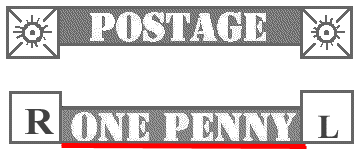On several of the Penny Black and 1841 Penny Red stamps the lower frame line may appear double or have a wavy appearance. It may even as in the case of Plate 1a appear that as though a line is running through the value. This
variety does not appear to show on heavily printed stamps but may often be seen on Plate 1b: TF, TI, TJ. Plate 2:
TH, TJ. Plate 3: AG, TB, TC, TE, TF, TI, TJ. Plate 4: TE, TH, TI. Plate 5: TE, TH, TI, TJ. Plate 6: TE, TF, TH, TI,
TL. Plate 7: TE. Plate 8: GL. Plate 9: TH, TI. Plate 10: TE, TF, TH, TI, TK. Plate 11: PD, PI, TC, TH.The double bottom may also be referred to as a shifted transfer or basal shift. This is not necessarily caused during
repair but occurs as a result of the original laying down of the impression. Therefore it is only a "re-entry" in the sense that it is a re-entered impression through a sift in the roller during transfer, and not a completely new application of the transfer roller. When the transfer roller is applying the impression it accidentally shifts and causes a doubling of the bottom. This is also known to occur at the top of the stamp as well. double bottoms are usually found on impressions at the bottom of the plate and basal shifts of the top frame line are found at the top of the sheet. Below is an example of a double bottom.

Plate 10 double bottom (highlighted in red)
Note that in this case the doubling falls strictly under the value tablet only